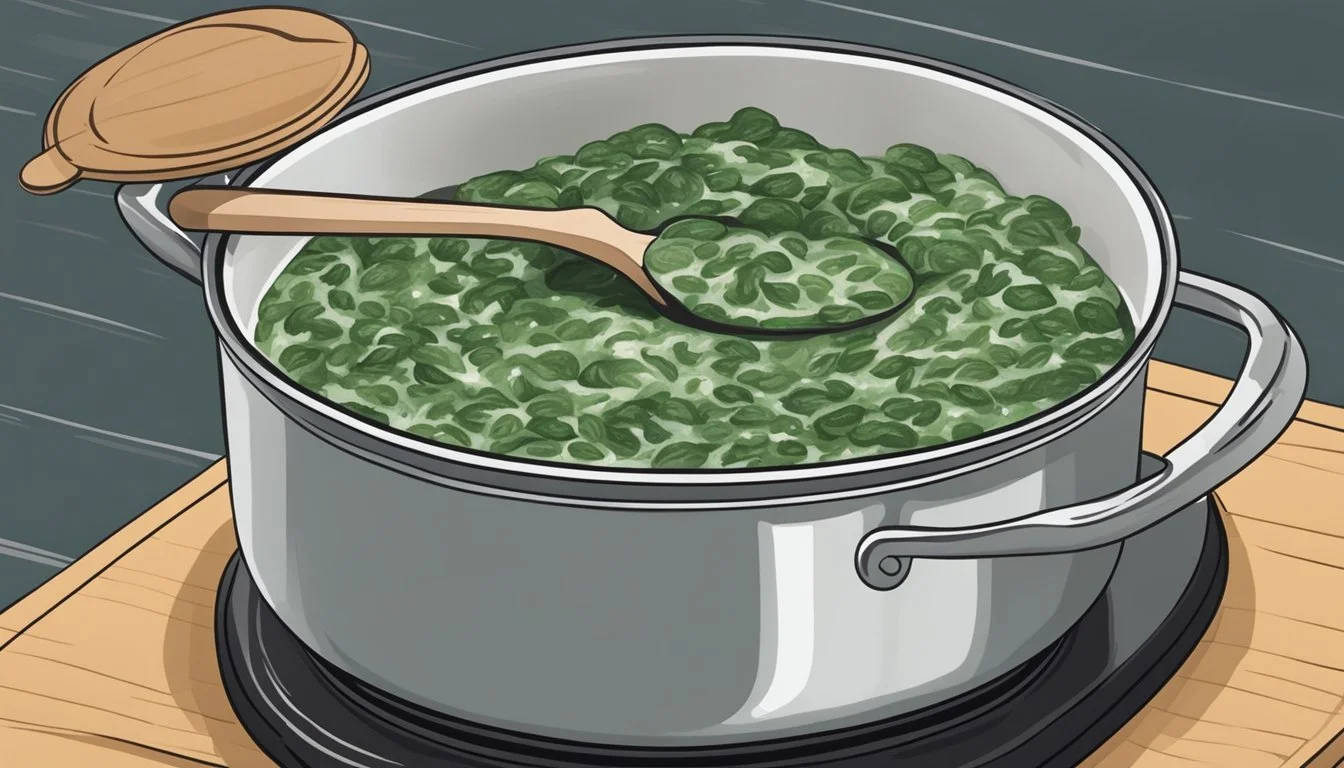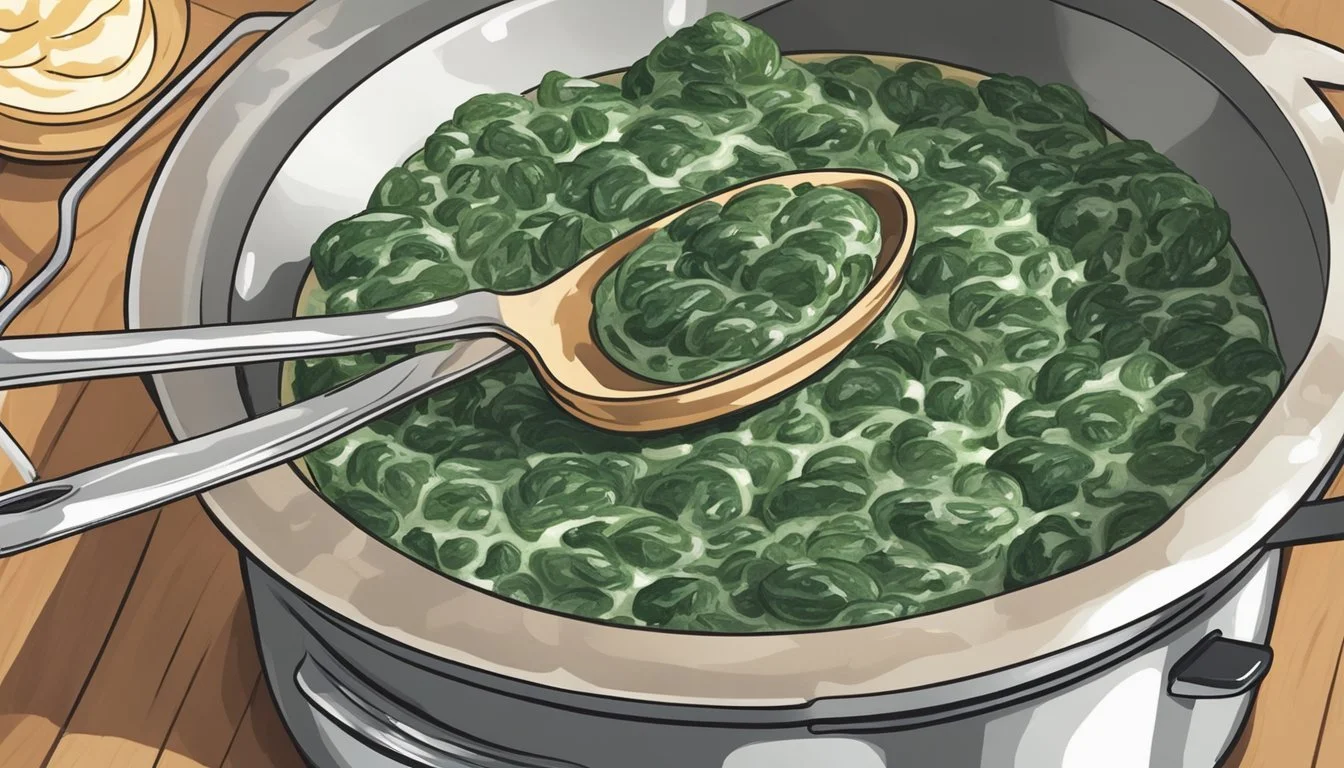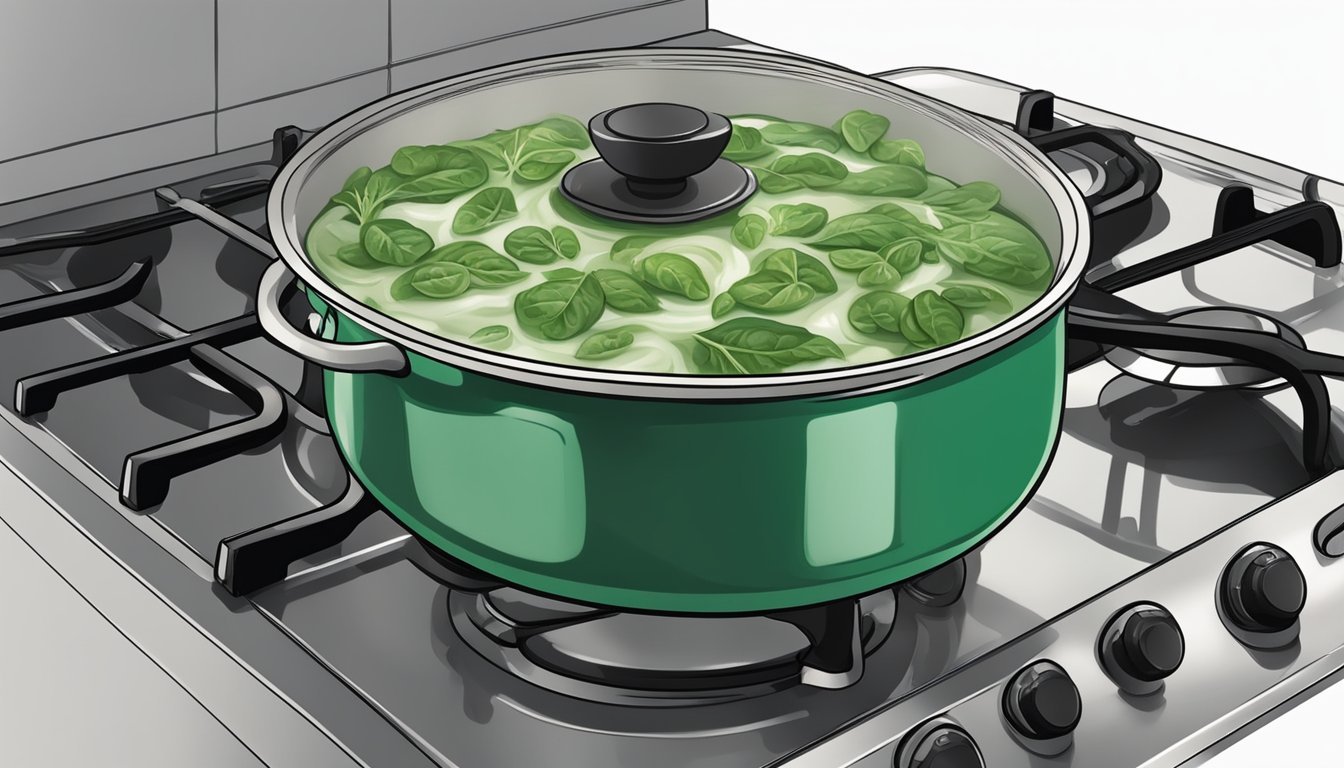Best Way to Reheat Creamed Spinach
Ensuring Perfect Creaminess and Texture Every Time
Creamed spinach (What wine goes well with spinach?) is a classic side dish known for its velvety texture and rich flavor. Ensuring that its creaminess and texture are maintained when reheated is crucial, as heat can often alter the consistency of dairy-based dishes. Careful consideration of reheating methods can prevent the creamed spinach from becoming grainy or separated. Using tried and tested techniques allows one to enjoy this side dish just as much the second time around, with all the qualities that made it delightful when first prepared.
Many home cooks and culinary experts agree on a variety of methods to successfully reheat creamed spinach while preserving its quality. The oven and stovetop are two of the most recommended ways, each offering distinct advantages in controlling temperature and moisture. Adding a small amount of liquid when reheating can aid in maintaining the original creaminess, while covering the dish helps to retain heat and prevent drying out. These methods, applied with attention to detail, can ensure the creamed spinach retains its desired texture and taste.
Understanding Creamed Spinach
Creamed spinach is a rich and savory dish often sought after for its smooth texture and comforting taste. Here's what one needs to know about its composition and key components.
Defining Creamed Spinach
Creamed spinach is a classic side dish comprised of spinach leaves that are cooked down and then mixed with a creamy sauce. This dish is typically served warm and is known for its velvety consistency and mild, comforting flavor profile that complements a variety of main courses.
Key Ingredients
The creaminess of creamed spinach is achieved through a combination of dairy ingredients and seasoning. Here is a breakdown of the essential components:
Spinach: The foundation of the dish, spinach is sautéed until wilted and then combined with the creamy mixture.
Cream Cheese: Often added for its smooth texture and mild tanginess, cream cheese helps to thicken the creamed spinach.
Heavy Cream: It provides richness and lushness to the dish, creating a luxurious mouthfeel.
Parmesan: A hard, aged cheese known for its savory flavor, parmesan is typically grated into the dish for added depth of taste.
Garlic: Generally used to infuse the creamed spinach with a subtle pungency and aromatic quality that complements the dairy elements.
Butter: Used as the initial fat to sauté the spinach and serves as a flavor enhancer throughout the dish, imparting a silky finish.
Preparation Before Reheating
To ensure creamed spinach retains its quality, proper handling before reheating is essential. Factors like storage and pre-reheating steps significantly influence the final texture and creaminess of the dish.
Proper Storage Techniques
When storing creamed spinach in the fridge, it should be allowed to cool completely to avoid condensation within the storage container. Once cooled, it must be transferred to an airtight container, minimizing exposure to air, which could potentially dry out the spinach or introduce unwanted odors.
Fridge Storage:
Allow to cool completely before refrigerating.
Transfer to an airtight container.
Ensure minimal headspace to reduce air exposure.
Freezer Storage (not recommended):
Although freezing is not advisable due to texture alteration upon thawing, if necessary, follow the same protocol as fridge storage and consume within a shorter time frame to maintain quality.
Preparing for Reheat
Prior to reheating, one should remove the creamed spinach from the fridge and let it sit at room temperature for a few minutes. This step reduces the thermal shock when reheated and can help in maintaining a consistent texture.
Remove from fridge and let sit for 10-15 minutes at room temperature.
Add a small amount of liquid (milk, water, or stock) — approximately 1-2 tablespoons per portion — to adjust consistency if needed. Stir it in gently before reheating.
Choosing the Right Reheating Method
When reheating creamed spinach, it's crucial to select a method that preserves its creaminess and texture. Different techniques offer varied results, suitable for specific preferences and available kitchen equipment.
Stovetop Reheating
Using a skillet on the stove allows for gentle reheating that keeps the spinach creamy. They should pour the creamed spinach into the skillet and warm it over medium-low heat, stirring occasionally to maintain an even temperature and prevent scorching.
Oven Reheating
Heating in an oven entails transferring the spinach into an oven-safe dish. It's advised to mix in a small amount of liquid—such as milk or stock—to enhance moisture. They cover the dish with aluminum foil to retain heat and prevent drying, then heat at a low temperature, around 300°F, checking and stirring after 5-10 minutes.
Microwave Reheating
For quick reheating, one can utilize a microwave. They place the creamed spinach in a microwave-safe dish, cover it—with a lid or damp paper towel—to trap steam, and reheat at medium power. They stir it after short intervals to ensure even heating and to avoid overcooking, which can harm its texture.
Avoiding Common Reheating Mistakes
To preserve the creamed spinach's qualities, one must avoid overheating and ensure sufficient moisture. They should not use high heat that can cause the cream to separate or curdle. Adding a bit of liquid helps maintain its consistency, and covering the dish during reheating prevents moisture loss.
Maintaining Creaminess and Texture
When reheating creamed spinach, the goal is to preserve its smooth, velvety consistency while preventing any undesirable changes in texture. The method chosen will greatly influence the outcome, requiring attention to moisture, heat intensity, and timing.
Adding Moisture
To ensure that the creamed spinach retains its creamy texture, one may need to introduce additional moisture during the reheating process. This can be especially true if the spinach has been stored in the refrigerator, as it may dry out over time.
Oven Method: When using the oven, adding 1-2 tablespoons of liquid, such as milk, water, stock, or heavy cream, per portion helps maintain moisture levels. Cover the dish with foil to keep the steam contained.
Stovetop Method: For those who prefer to reheat on the stovetop, stirring in a small amount of butter or heavy cream as the spinach warms can replenish moisture and enrich the dish's texture.
Prevent Burning and Drying Out
Avoiding burnt or dried-out creamed spinach involves controlling the heating environment.
Oven Precautions: Preheat to a moderate temperature, around 300°F (150°C), and use a covered baking dish to protect the contents from direct, intense heat.
Stovetop Care: Reheat the creamed spinach over medium-low heat, stirring occasionally. One can reduce the risk of burning by using lower heat and preventing the mixture from boiling.
Pacing Heating Time
Careful monitoring of heating time is crucial for maintaining the dish's creamy texture. Overheating can lead to separation and a grainy texture, especially if cheese is involved.
Oven Timing: In the oven, creamed spinach usually requires between 15-20 minutes to reach a safe internal temperature of 165°F (74°C) without overcooking.
Microwave Method: If using a microwave, cover the dish with a damp paper towel to provide a gentle steam environment and heat in short bursts, stirring at intervals to evenly distribute heat without drying out the spinach.
Serving and Pairings
Once reheated to perfection, creamed spinach serves as an excellent accompaniment to numerous dishes. Its rich texture and versatility make it an ideal pairing for different types of meals, ranging from simple pastas to sophisticated steaks.
Complementary Side Dishes
Creamed spinach enriches the flavor of several side dishes. It pairs particularly well with:
Grains: A simple serving of white or brown rice can balance the creaminess of the spinach.
Potatoes: Mashed, baked, or roasted potatoes offer a comforting texture contrast.
Main Dishes to Accompany Creamed Spinach
Given its savory profile, creamed spinach augments the taste of main courses such as:
Steaks: A classic ribeye or sirloin steak (What wine goes well with sirloin steak?) is elevated when creamed spinach is served alongside.
Pasta: A dish of pasta, ideally something lighter like angel hair or a stuffed pasta such as ravioli, makes for a delightful combination.
Presentation Ideas
A thoughtful presentation enhances the dining experience. Consider these tips:
Sprinkle with Parmesan cheese: A light dusting adds a salty, nutty flavor.
Include color with Salads: A green salad with vibrant vinaigrette can break the richness and add a refreshing bite.
Casseroles: Layer creamed spinach in casseroles for visual appeal and creamy texture.
Food Safety and Tips
When reheating creamed spinach, maintaining both the quality of the dish and adherence to food safety standards is crucial. Proper handling and reheating techniques ensure the spinach retains its creaminess and texture, while also preventing foodborne illness.
Reheating Multiple Times
One should only reheat creamed spinach once. Repeated reheating can compromise both the taste and safety of the dish. It can lead to uneven reheating, with parts of the spinach reaching the desired temperature while others do not, creating a potential for bacterial growth.
Key Steps to Safe Reheating:
Even reheating: Stir the creamed spinach occasionally to ensure it heats evenly.
Minimum internal temperature: Heat to at least 165°F (74°C) for safe consumption.
Handling Leftovers Safely
Proper storage of leftovers is essential to food safety. One should refrigerate creamed spinach within two hours of cooking to prevent bacterial growth. Here's how to handle leftovers safely:
Storage Tips:
Refrigerator temperature: Keep at 40°F (4°C) or below.
Airtight containers: Store in airtight containers to prevent odors and condensation.
Prompt use: Consume reheated leftovers within 3-4 days for best quality and safety.
Frequently Asked Questions
Navigating the reheating process of creamed spinach can be tricky, especially when attempting to preserve its creaminess and avoid separation. This section addresses common questions to ensure your dish remains delicious and as close to its original state as possible.
Reheat Creamed Spinach Without It Separating
To keep creamed spinach from separating during reheating, it should be done gently and at a lower temperature. One should reheat in the oven by setting it to 300°F (150°C), covering the dish with foil, and adding a small amount of liquid—such as whole milk or stock—to prevent drying out. Stirring halfway through the process is crucial for even heating and maintaining texture. Alternatively, on the stovetop, reheating over medium-low heat while stirring occasionally helps to maintain a uniform creamy consistency.
Reducing Calories While Reheating
If one is looking to reduce calories when reheating creamed spinach, consider opting for low-fat milk or a milk alternative in place of whole milk or heavy cream. Additionally, using a moderate amount of a lower-calorie substitute like a light cream cheese can help cut down on calories while still providing a creamy texture. Adding a splash of broth can also maintain moisture without the extra calories.
Alternatives to Cream and Cheese
For those seeking alternatives to cream and cheese when reheating creamed spinach, there are a few options. Olive oil blended with a bit of flour can act as a roux to thicken the spinach and add creaminess with less fat than traditional cheese or cream. This mix can be gently heated and stirred into the spinach. Nutritional yeast is a flavorful cheese substitute that can be sprinkled on top before reheating to give a cheesy taste without actual cheese.
Additional Information
To make reheating creamed spinach a success, it's important to consider factors such as adjusting for different quantities and enhancing the dish with additional ingredients, while also being mindful of nutritional aspects.
Adjusting Servings and Scaling Recipe
One may need to alter the quantity of creamed spinach, whether scaling up for a large gathering or reducing for a smaller, intimate meal. When adjusting the servings, it's crucial to maintain the ingredient proportions to ensure the dish's flavor and texture remain consistent. For example, if doubling the recipe, make sure to also double ingredients like nutmeg and liquid to preserve the creamed spinach's fragrant signature taste.
Incorporating Other Vegetables
Enhanced versatility in the dish can be achieved by adding a variety of other vegetables. One can introduce fresh spinach or frozen spinach to the creamed mixture, following proper defrosting and draining procedures for frozen spinach to avoid excess moisture. Beyond spinach, consider blending into the cream sauce tender vegetables such as kale or Swiss chard, ensuring they're properly cooked to achieve a harmonious texture.
Nutritional Information
Concerning the nutritional information of the dish, creamed spinach is rich in iron and vitamins provided by the leafy greens. However, the addition of cream and butter increases the calorie and fat content. To offer a healthier option, one could substitute heavy cream with lower-fat alternatives like milk or a light cream, noting the potential change in flavor and consistency. As part of food safety practices, ensure any leftover creamed spinach reaches an internal temperature of 165°F (74°C) before consumption.








